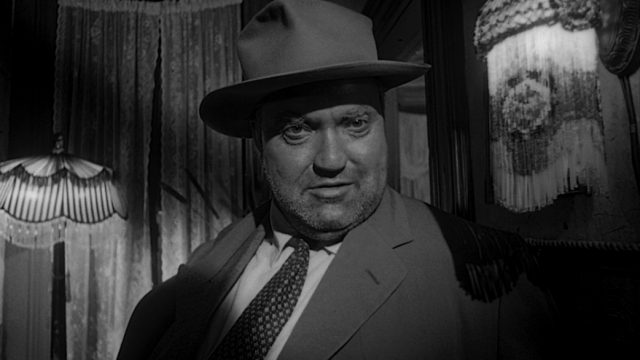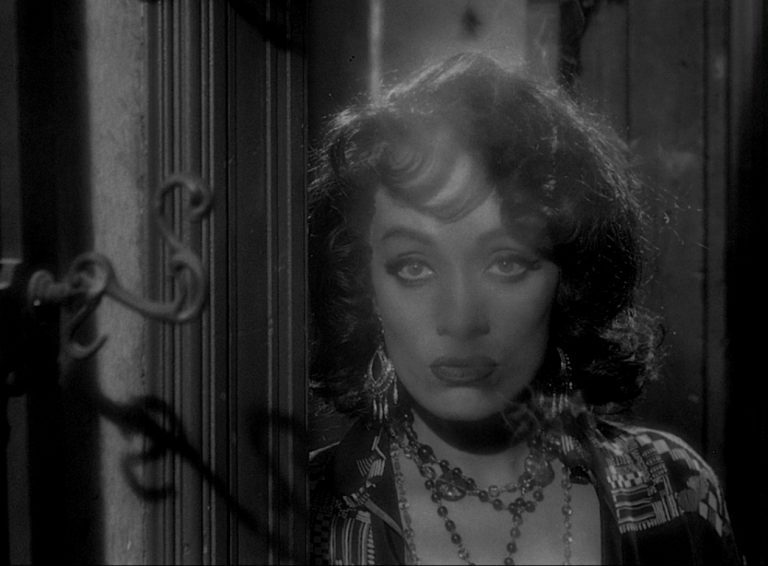“It’s a free country.”
“Shut up.”
The opening tracking shot may be its most audacious, and get a lion’s share of the attention, but the thing about Touch of Evil is that it never stops moving. A lot of its foundational elements are already there in those first three minutes: the danger that is closer to the characters than they know, the movements of antagonistic forces they’re unaware of, both the union and the separation between Mexico and the U.S. The explosion of the Chrysler convertible is a force that gives the film its first cut and sends it flying into several parallel storylines, whose players will harass, escape, pursue and destroy one another.
It doesn’t so much alter the film’s world as reveals it as the always askew, always twisted, crooked and distorted universe that it is. Corrupt policemen come into conflict with criminals who are no less insidious for how comical they appear, and how improvisational their actions often are. Uneasy alliances end in cold-blooded murder. Individuals within ostensible power structures act on their own, leaving literal acid burning through walls. A lawman puts intuition and prejudice over reason and facts. It’s dangerous to be alone and dangerous to be in a crowd. When “Uncle” Joe Grandi (Akim Tamiroff)’s leather jacket-clad family members need to find a way to menace Susie Vargas (Janet Leigh) without laying a hand on her, they do it via a rock-n-roll party next door; in a mockingly surreal touch, they deflect her attempt to call the police by informing her, on the telephone, that the telephone is out of service. Perhaps no one is given cause to feel the uncanny wrongness of it all more deeply than Dennis Weaver’s half-mad motel night manager: “It’s day already… I’m the night man. There ain’t no day man.” What the hell is this?
Both the story and the style are the stuff of beautifully controlled chaos, and they come together in what is, ultimately, a remarkably cohesive and focused vision, although it can take more than one viewing to come to be entranced by the film’s essentially assaultive strategy. Orson Welles, back in Hollywood after a decade-long absence and high as ever on the possibilities of moviemaking, had spent much of the 1950s engaged in a dizzying multitude of theatre, radio, film and television projects that took him all over Europe and back to New York, and that he could lose interest in a long time before they were due to be completed, or otherwise attempt to complete for years; by this time, Hollywood, with which he had parted bitterly in the late 1940s, felt more like a paradise he was ejected from. Welles knew what Touch of Evil meant for him – and what it could mean in the future, though, sadly, it never did – and threw everything he had into it, efficient while keeping his creative juices in a free flow (“I don’t make films, I carry out experiments”), aided and abetted by a highly professional and properly energized cast and crew. (It was cinematographer Russell Metty who suggested the opening scene be a single take, something Welles did not hesitate to credit him for.)
Touch of Evil’s disparate elements – the disturbing characters and events, the carved-up light and shadows, the sharp angles and equally unexpected cuts and long takes, the artificial, selectively evoked feel of the border town (actually shot in Venice, California, “the Slum by the sea”), Henry Mancini’s gloriously unhinged score, with its relentless conga drums and blaring trumpets – come together to create a constant feeling of a waking nightmare, with the film regularly achieving peak-silent-movie expressiveness. All the while, it’s underpinned by both tight, action-based crime-fiction plotting – Welles reportedly loved narrative-driven pulp so much he travelled everywhere with a suitcase full of genre novels throughout his life, at times consuming one or two per day, and this was the best of the few opportunities he got to put such a story onscreen – and the director’s long-term obsessions and concerns that found a home within it.
“I’m willing to admit that the policeman has a difficult job; a very hard job. But it’s the essence of our society that the policeman’s job should be hard. He’s there to protect – protect the free citizens. Not to chase criminals – that’s the incidental part of the job. A free citizen is always more of a nuisance to the policeman than the criminal: he knows what to do about the criminal. We should be grateful for the policeman, but I think that we should be grateful, too, for the laws which protect us against the policeman. […] I’m not an anarchist; I don’t want to overthrow the rule of law. On the contrary: I want to bring the policeman to law.” That’s Welles in 1955 on Orson Welles’ Sketch Book, a six-part BBC series of 15-minute programmes that consisted of him simply speaking his mind to the audience about a range of subjects. It’s the Welles who, nearly a decade earlier, passionately crusaded on behalf of Isaac Woodard, a black WWII veteran blinded by South Carolina police, and the Welles who, at the 1958 Cannes film festival, would say in an interview with André Bazin that he’d rather have crime go unpunished than the police be authorized to abuse their power.
And certainly it’s the Welles who wrote and acted in Touch of Evil, his Hank Quinlan a monstrous mountain of a racist cop in the long line of the director’s mythic, slippery, larger-than-life men, stretching from Charles Foster Kane to Jake Hannaford, – figures he was attracted to, even when repulsed by, both in life and in every artistic medium. Welles’ personal liberal idealism and his fascination with Quinlan, and the evil he represents, are nicely counterbalanced, his only arguable misstep being in giving the character a murdered-wife backstory, which is important but awkwardly brought up, and makes him more tragic but less unknowable. If Charlton Heston’s Miguel Vargas evidently shares and voices all of the director’s own convictions, Quinlan is a more naturally Wellesian character, in more ways than one; this adds to the feeling of watching Welles, on some level, argue with and confront himself (“Vargas’ll turn you into one of those starry-eyed idealists… They’re worse than crooks. You can always do something with a crook”), and makes the clarity with which Quinlan is shown projecting his own prejudice and corruption on those who suffer from it, knowing perfectly well what he’s doing, all the more bone-chilling.
Of course, he wouldn’t be a quintessential Welles character if he did not suffer from those quintessential Welles dangers that are betrayal and nostalgia. As obviously bad as Quinlan is, Touch of Evil does not condescend to him; his arrogant resentment at having his authority suspected and questioned comes from a real place, and when the conscientious Sgt. Menzies (Joseph Calleia), for whom he once took a bullet and whom he partly shaped (“I am what I am because of him”), turns against him, having decided to draw the line at outright murder, it is necessary and painful and ugly. (Quinlan ends up betraying himself, as well: by the end of the film, Manolo Sanchez (Victor Millan) has confessed to the opening car murder, having presumably been driven to commit it to retaliate against his white wife’s disapproving father. The cop’s planting of evidence was not necessary. But then, Sanchez doesn’t have to be innocent for Quinlan to be more guilty of what he’s done.) But before that has to happen, he will be drawn one last time by the rueful siren call of the pianola that belongs to Tana, played by Marlene Dietrich at her most magnificently world-weary. Used to be, he’d hole up at her place with a case of whiskey for days on end. Now he’s a body floating in wastewater, exposed and disgraced, and whatever else there was, or could have been, is not for us to know.


